Liquid Cooling For AI Data Centers Market Size 2025-2029
The liquid cooling for ai data centers market size is valued to increase by USD 1.88 billion, at a CAGR of 31.4% from 2024 to 2029. Escalating thermal design power and compute density of AI accelerators will drive the liquid cooling for ai data centers market.
Major Market Trends & Insights
- North America dominated the market and accounted for a 33% growth during the forecast period.
- By Type - Cold plate cooling segment was valued at USD 86.50 billion in 2023
- By End-user - Hyperscale data centers segment accounted for the largest market revenue share in 2023
Market Size & Forecast
- Market Opportunities: USD 1.00 million
- Market Future Opportunities: USD 1876.60 million
- CAGR from 2024 to 2029 : 31.4%
Market Summary
- In the realm of AI data centers, the demand for advanced cooling solutions has escalated, driven by the increasing thermal design power and compute density of artificial intelligence (AI) accelerators. Liquid cooling, a sophisticated approach to managing heat, has emerged as a viable alternative to traditional air cooling. The market for liquid cooling in AI data centers is projected to reach USD10 billion by 2026, underscoring its growing significance. Hybrid cooling architectures, which combine liquid and air cooling, have gained traction due to their pragmatic deployment in managing the complex thermal requirements of AI systems. However, the high initial capital expenditure and retrofitting complexity associated with liquid cooling implementation pose challenges for businesses.
- Despite these hurdles, the benefits of enhanced cooling efficiency, increased power density, and improved reliability make liquid cooling an attractive investment for AI data centers. The future direction of this market lies in the continuous innovation of cooling technologies, ensuring the uninterrupted operation of AI systems and driving business growth.
What will be the Size of the Liquid Cooling For AI Data Centers Market during the forecast period?
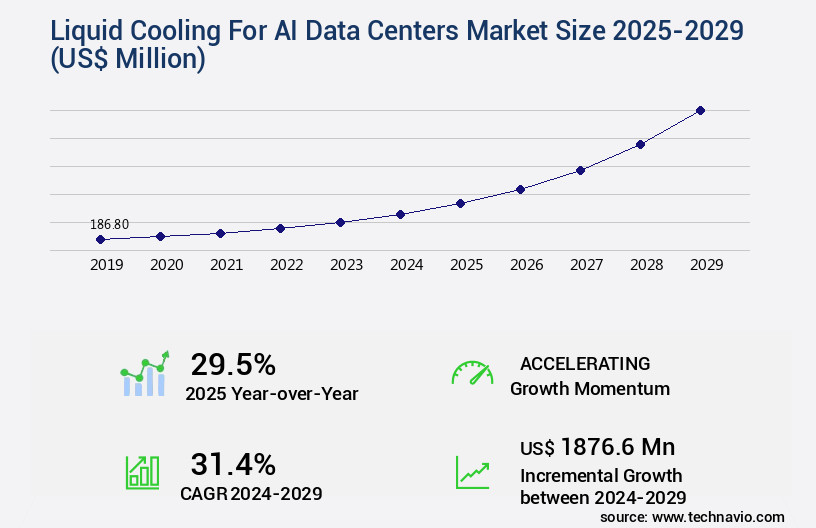
Get Key Insights on Market Forecast (PDF) Request Free Sample
How is the Liquid Cooling For AI Data Centers Market Segmented ?
The liquid cooling for ai data centers industry research report provides comprehensive data (region-wise segment analysis), with forecasts and estimates in "USD million" for the period 2025-2029, as well as historical data from 2019-2023 for the following segments.
- Type
- Cold plate cooling
- Immersion cooling
- Spray liquid cooling
- End-user
- Hyperscale data centers
- Colocation data centers
- Others
- Component
- Geography
- North America
- Europe
- France
- Germany
- The Netherlands
- UK
- APAC
- Rest of World (ROW)
By Type Insights
The cold plate cooling segment is estimated to witness significant growth during the forecast period.
In the dynamic landscape of AI data centers, liquid cooling infrastructure continues to gain traction as an effective solution for managing the heat dissipation rates of high-density server racks. Liquid cooling for AI data centers encompasses various techniques, including cold plate cooling, immersion cooling, and two-phase immersion cooling. Among these, cold plate cooling, also known as direct-to-chip or D2C liquid cooling, is currently the fastest growing segment. This technology employs a cold plate, which is a metal plate affixed directly onto the primary heat-generating components of a server, such as GPUs or CPUs. The cold plate, containing microchannels filled with a liquid coolant, absorbs heat directly from the source and transports it away via a closed loop system to a coolant distribution unit for heat rejection.
This closed loop system integrates leak detection systems, redundancy design, and filtration systems to ensure fault tolerance and scalability. Predictive maintenance and thermal modeling software optimize cooling capacity and energy efficiency metrics. Liquid cooling pumps, refrigeration cycles, and airflow management further enhance thermal runaway prevention and waste heat recovery. The market for liquid cooling in AI data centers is expected to grow significantly, with a projected Compound Annual Growth Rate (CAGR) of 18.5% from 2021 to 2028.
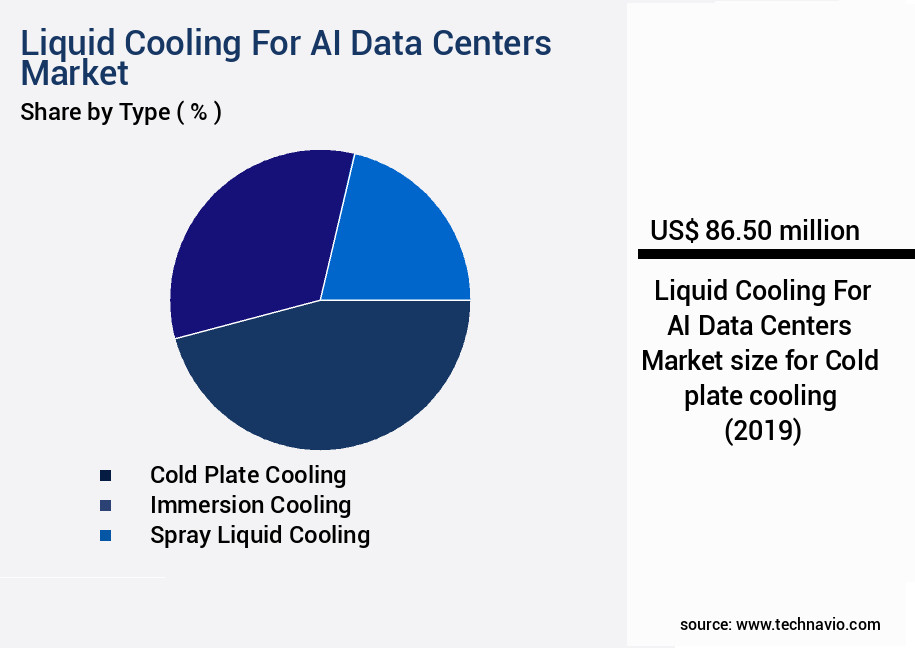
Request Free Sample
The Cold plate cooling segment was valued at USD 86.50 billion in 2019 and showed a gradual increase during the forecast period.
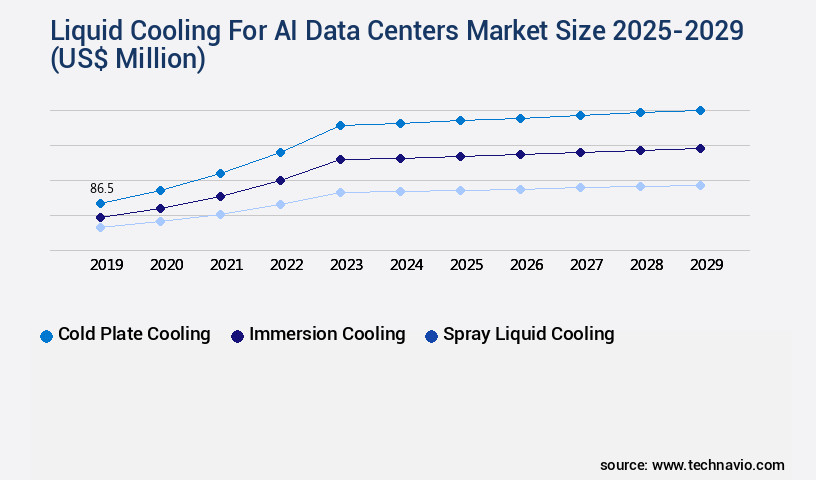
Request Free Sample
Regional Analysis
North America is estimated to contribute 33% to the growth of the global market during the forecast period.Technavio’s analysts have elaborately explained the regional trends and drivers that shape the market during the forecast period.
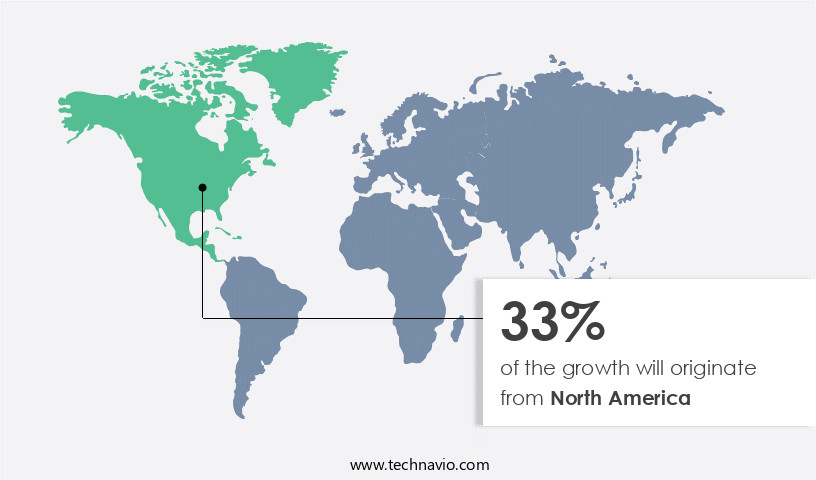
See How Liquid Cooling For AI Data Centers Market Demand is Rising in North America Request Free Sample
The market is witnessing significant advancements, with North America leading the charge. Comprising primarily the United States and Canada, this region is poised to retain its market dominance due to the presence of a substantial number of hyperscale cloud providers, a thriving AI research and development ecosystem, and substantial investments in advanced computing infrastructure. The United States, specifically, is the global hub for AI innovation, hosting tech giants like Google, Microsoft, Meta, and Amazon Web Services. These companies are intensely competing to create and deploy advanced large language models and generative AI services, necessitating the utilization of high-density GPU clusters.
Consequently, the demand for liquid cooling solutions to manage the escalating thermal challenges is surging. According to recent reports, the North American market is projected to account for over 45% of the global market share by 2027, up from approximately 40% in 2020. This growth can be attributed to the region's robust IT infrastructure and the increasing adoption of AI technologies.
Market Dynamics
Our researchers analyzed the data with 2024 as the base year, along with the key drivers, trends, and challenges. A holistic analysis of drivers will help companies refine their marketing strategies to gain a competitive advantage.
The global market for liquid cooling in AI data centers is experiencing significant growth as organizations seek to optimize cooling infrastructure for their high-density AI servers. Liquid cooling offers an effective solution for reducing PUE (Power Usage Effectiveness) through advanced cooling techniques, ultimately leading to substantial energy savings. Two-phase immersion cooling, a popular liquid cooling method, has gained traction in AI data centers due to its ability to directly cool components, thereby minimizing the thermal load on the IT equipment.
Design considerations for efficient liquid cooling systems are crucial, including managing thermal runaway risks and ensuring safety protocols are in place. Liquid cooling system maintenance and predictive modeling are essential to mitigate potential issues and ensure system reliability. Water-based liquid cooling solutions are increasingly being adopted for AI workloads due to their ability to handle high thermal loads and improve energy efficiency.
Comparing different liquid cooling technologies for AI data centers is essential to evaluate their reliability in high-performance computing environments. Cost analysis of various liquid cooling implementations is also crucial to determine the most cost-effective solution for specific use cases. Scalability challenges with liquid cooling in large AI data centers must be addressed to ensure seamless expansion.
Improving energy efficiency using liquid cooling in AI deployments is a significant driver for adoption, as it enables reducing operational costs and achieving sustainable data centers. Environmental impact assessment of liquid cooling infrastructure is also crucial to ensure the technology aligns with corporate sustainability goals. Advanced monitoring techniques for liquid cooling systems and data center thermal modeling and simulation are essential to ensure optimal performance and prevent potential issues. Liquid cooling plays a vital role in achieving sustainable data centers by reducing energy consumption and improving overall efficiency.
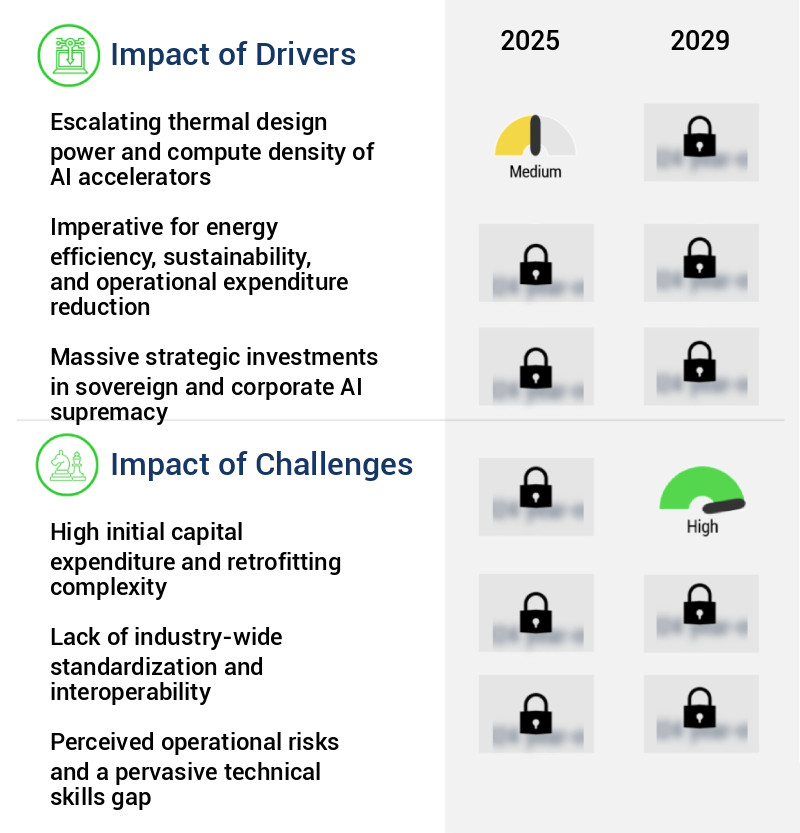
What are the key market drivers leading to the rise in the adoption of Liquid Cooling For AI Data Centers Industry?
- The increasing thermal design power and compute density of artificial intelligence (AI) accelerators serve as the primary catalyst for market growth.
- The global liquid cooling for AI data center market is experiencing significant growth due to the escalating thermal design power (TDP) of specialized processors used in artificial intelligence workloads. TDP, a measure of a component's maximum heat generation, has surpassed the capabilities of traditional air cooling. AI accelerators, such as high-end graphics processing units (GPUs), are designed for massively parallel computation, which is power-intensive and generates vast amounts of heat in a confined space. As semiconductor manufacturers continue to innovate through advanced silicon processes and chiplet architectures, the heat flux has become too extreme for air's low thermal conductivity to effectively dissipate.
- This situation necessitates the adoption of liquid cooling solutions to manage the heat efficiently and maintain optimal operating temperatures for AI systems.
What are the market trends shaping the Liquid Cooling For AI Data Centers Industry?
- The rising trend in the market involves the implementation of hybrid cooling architectures for practical deployment.
Hybrid cooling architectures are set to become the market trend for pragmatic deployment.
- Liquid cooling for AI data centers is witnessing significant advancements, with hybrid thermal management architectures gaining traction. This approach combines the benefits of both air and liquid cooling, allowing data center operators to efficiently manage heat loads. In a hybrid model, liquid cooling is applied directly to the chips of AI accelerators, such as graphics processing units and central processing units, through cold plates. This targeted cooling method reduces the thermal resistance and enhances the overall performance of the data center. The adoption of liquid cooling in AI data centers is projected to increase, driven by the growing demand for high-performance computing and the need to minimize energy consumption.
- According to recent estimates, the global market for liquid cooling in data centers is expected to reach approximately 12% of the total data center cooling market share by 2025. This underscores the importance of liquid cooling as a viable solution for managing the extreme heat generated by AI workloads.
What challenges does the Liquid Cooling For AI Data Centers Industry face during its growth?
- The high initial capital expenditures and intricate retrofitting complexities pose a significant challenge to the industry's growth trajectory.
- Liquid cooling for AI data centers is an evolving market characterized by its complex infrastructure and substantial initial capital expenditure. Unlike traditional air cooling, which utilizes computer room air handlers (CRAHs) and hot/cold aisle containment, liquid cooling necessitates specialized components such as coolant distribution units (CDUs), intricate piping networks, and heat rejection systems. These elements require a significant investment and add complexity to the cooling infrastructure. The benefits, however, include increased power density and efficiency, making liquid cooling an attractive solution for sectors with high computational demands, such as finance, healthcare, and research institutions.
- For instance, liquid cooling can increase server rack power density by up to 50% compared to air cooling, while reducing energy consumption by up to 40%. Despite these advantages, the high CapEx and intricacy of retrofitting existing facilities remain major challenges to the widespread adoption of liquid cooling in AI data centers.
Exclusive Technavio Analysis on Customer Landscape
The liquid cooling for ai data centers market forecasting report includes the adoption lifecycle of the market, covering from the innovator’s stage to the laggard’s stage. It focuses on adoption rates in different regions based on penetration. Furthermore, the liquid cooling for ai data centers market report also includes key purchase criteria and drivers of price sensitivity to help companies evaluate and develop their market growth analysis strategies.
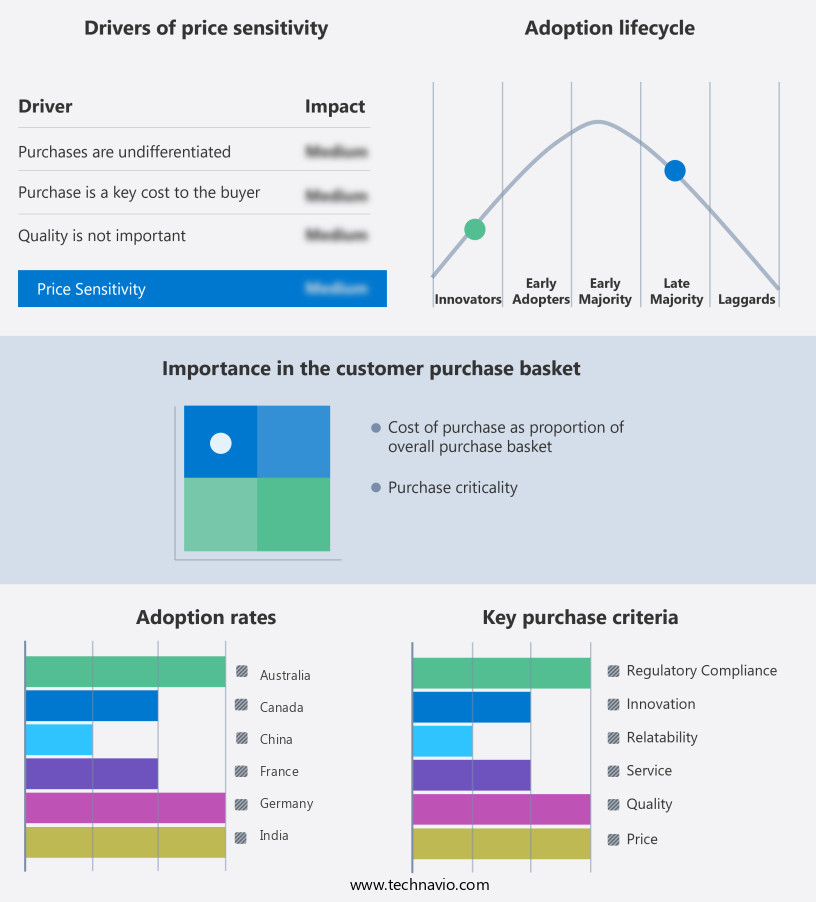
Customer Landscape of Liquid Cooling For AI Data Centers Industry
Competitive Landscape
Companies are implementing various strategies, such as strategic alliances, liquid cooling for ai data centers market forecast, partnerships, mergers and acquisitions, geographical expansion, and product/service launches, to enhance their presence in the industry.
Asetek - The company specializes in Direct-to-Chip (D2C) liquid cooling technology, delivering innovative solutions for cooling CPUs and GPUs. Their offerings include a variety of D2C systems and rack-level Cold Plate Distribution Units (CDUs), enabling efficient liquid loop management.
The industry research and growth report includes detailed analyses of the competitive landscape of the market and information about key companies, including:
- Asetek
- Coolit Systems
- Daikin Industries Ltd.
- Delta Electronics Inc.
- Green Revolution Cooling Inc.
- Hewlett Packard Enterprise Co.
- Iceotope Technologies Ltd.
- Lenovo Group Ltd.
- LiquidCool Solutions
- LiquidStack BV
- Nortek
- Rittal GmbH and Co. KG
- Schneider Electric SE
- STULZ GmbH
- Submer Technologies SL
- Super Micro Computer Inc.
- Vertiv Holdings Co.
- ZutaCore, Inc.
Qualitative and quantitative analysis of companies has been conducted to help clients understand the wider business environment as well as the strengths and weaknesses of key industry players. Data is qualitatively analyzed to categorize companies as pure play, category-focused, industry-focused, and diversified; it is quantitatively analyzed to categorize companies as dominant, leading, strong, tentative, and weak.
Recent Development and News in Liquid Cooling For AI Data Centers Market
- In January 2024, IBM announced the launch of its new AI data center in Zurich, Switzerland, utilizing IBM's innovative liquid-cooled AI systems, reducing the carbon footprint by 90% compared to traditional air-cooled data centers (IBM Press Release). In March 2024, Intel and Microsoft entered into a strategic partnership to develop and deploy liquid-cooled data centers, aiming to increase efficiency and performance in AI workloads (Microsoft News Center). In May 2024, NVIDIA secured a USD200 million investment from SoftBank Vision Fund 2 to expand its liquid-cooled data center infrastructure and accelerate AI innovation (NVIDIA Press Release). In April 2025, Google revealed its plans to build a new liquid-cooled AI data center in Finland, aiming to reduce energy consumption and enhance the performance of its AI services (Google Cloud Blog). These developments demonstrate significant advancements in the market, with major tech companies investing heavily in this technology to improve efficiency, reduce carbon footprint, and enhance AI capabilities. (Sources: IBM Press Release, Microsoft News Center, NVIDIA Press Release, Google Cloud Blog)
Dive into Technavio’s robust research methodology, blending expert interviews, extensive data synthesis, and validated models for unparalleled Liquid Cooling For AI Data Centers Market insights. See full methodology.
|
Market Scope
|
|
Report Coverage
|
Details
|
|
Page number
|
237
|
|
Base year
|
2024
|
|
Historic period
|
2019-2023 |
|
Forecast period
|
2025-2029
|
|
Growth momentum & CAGR
|
Accelerate at a CAGR of 31.4%
|
|
Market growth 2025-2029
|
USD 1876.6 million
|
|
Market structure
|
Fragmented
|
|
YoY growth 2024-2025(%)
|
29.5
|
|
Key countries
|
US, China, Japan, India, Canada, Germany, France, UK, Australia, and The Netherlands
|
|
Competitive landscape
|
Leading Companies, Market Positioning of Companies, Competitive Strategies, and Industry Risks
|
Request Free Sample
Research Analyst Overview
- The liquid cooling infrastructure market for AI data centers continues to evolve, driven by the increasing demand for high-performance computing and the need for efficient cooling solutions. Redundancy design plays a crucial role in ensuring uninterrupted operation, with leak detection systems providing early warning of potential issues. AI server cooling relies heavily on liquid cooling pumps, which must be maintained through predictive maintenance to prevent thermal runaway and ensure optimal airflow management. Two-phase immersion cooling and direct-to-chip cooling are gaining popularity due to their ability to enhance thermal modeling software and improve cooling capacity optimization.
- Scalability considerations and fault tolerance are essential factors in the design of liquid cooling systems, with filtration systems and refrigeration cycles ensuring the longevity of the infrastructure. High-density server racks demand innovative cooling solutions, with waste heat recovery and heat dissipation rates becoming critical metrics for energy efficiency. Cooling capacity optimization and the use of heat transfer fluids are key strategies for maximizing the performance of liquid cooling systems. Evaporative cooling and rack-level cooling are also being explored to address the challenges of cooling large-scale AI data centers. According to industry reports, the liquid cooling infrastructure market for AI data centers is expected to grow by over 20% annually, driven by the increasing adoption of advanced cooling technologies and the need for energy-efficient solutions.
- For instance, a leading tech company reported a 30% increase in server performance after implementing a liquid cooling solution.
What are the Key Data Covered in this Liquid Cooling For AI Data Centers Market Research and Growth Report?
-
What is the expected growth of the Liquid Cooling For AI Data Centers Market between 2025 and 2029?
-
What segmentation does the market report cover?
-
The report is segmented by Type (Cold plate cooling, Immersion cooling, and Spray liquid cooling), End-user (Hyperscale data centers, Colocation data centers, and Others), Component (Solutions and Services), and Geography (North America, APAC, Europe, South America, and Middle East and Africa)
-
Which regions are analyzed in the report?
-
North America, APAC, Europe, South America, and Middle East and Africa
-
What are the key growth drivers and market challenges?
-
Who are the major players in the Liquid Cooling For AI Data Centers Market?
-
Asetek, Coolit Systems, Daikin Industries Ltd., Delta Electronics Inc., Green Revolution Cooling Inc., Hewlett Packard Enterprise Co., Iceotope Technologies Ltd., Lenovo Group Ltd., LiquidCool Solutions, LiquidStack BV, Nortek, Rittal GmbH and Co. KG, Schneider Electric SE, STULZ GmbH, Submer Technologies SL, Super Micro Computer Inc., Vertiv Holdings Co., and ZutaCore, Inc.
Market Research Insights
- The market for liquid cooling in AI data centers is a dynamic and evolving sector, continually adapting to the increasing demands of advanced technology. Liquid cooling technology offers enhanced system performance by efficiently managing heat generated by AI processors. For instance, implementing this technology can lead to a 30% reduction in energy consumption compared to traditional air cooling methods. Moreover, the industry anticipates a compound annual growth rate (CAGR) of approximately 25% over the next five years, driven by the need for higher cooling capacity, improved maintenance scheduling, and thermal management strategies.
- This growth is expected to result in a significant market expansion, with liquid cooling solutions becoming increasingly prevalent in data centers worldwide.
We can help! Our analysts can customize this liquid cooling for ai data centers market research report to meet your requirements.
Get in touch
1 Executive Summary
- 1.1 Market overview
- Executive Summary - Chart on Market Overview
- Executive Summary - Data Table on Market Overview
- Executive Summary - Chart on Global Market Characteristics
- Executive Summary - Chart on Market by Geography
- Executive Summary - Chart on Market Segmentation by Type
- Executive Summary - Chart on Market Segmentation by End-user
- Executive Summary - Chart on Market Segmentation by Component
- Executive Summary - Chart on Incremental Growth
- Executive Summary - Data Table on Incremental Growth
- Executive Summary - Chart on Company Market Positioning
2 Technavio Analysis
- 2.1 Analysis of price sensitivity, lifecycle, customer purchase basket, adoption rates, and purchase criteria
- Analysis of price sensitivity, lifecycle, customer purchase basket, adoption rates, and purchase criteria
- 2.2 Criticality of inputs and Factors of differentiation
- Overview on criticality of inputs and factors of differentiation
- 2.3 Factors of disruption
- Overview on factors of disruption
- 2.4 Impact of drivers and challenges
- Impact of drivers and challenges in 2024 and 2029
3 Market Landscape
- 3.1 Market ecosystem
- Parent Market
- Data Table on - Parent Market
- 3.2 Market characteristics
- Market characteristics analysis
4 Market Sizing
- 4.1 Market definition
- Offerings of companies included in the market definition
- 4.2 Market segment analysis
- 4.4 Market outlook: Forecast for 2024-2029
- Chart on Global - Market size and forecast 2024-2029 ($ million)
- Data Table on Global - Market size and forecast 2024-2029 ($ million)
- Chart on Global Market: Year-over-year growth 2024-2029 (%)
- Data Table on Global Market: Year-over-year growth 2024-2029 (%)
5 Historic Market Size
- 5.1 Global Liquid Cooling For AI Data Centers Market 2019 - 2023
- Historic Market Size - Data Table on Global Liquid Cooling For AI Data Centers Market 2019 - 2023 ($ million)
- 5.2 Type segment analysis 2019 - 2023
- Historic Market Size - Type Segment 2019 - 2023 ($ million)
- 5.3 End-user segment analysis 2019 - 2023
- Historic Market Size - End-user Segment 2019 - 2023 ($ million)
- 5.4 Component segment analysis 2019 - 2023
- Historic Market Size - Component Segment 2019 - 2023 ($ million)
- 5.5 Geography segment analysis 2019 - 2023
- Historic Market Size - Geography Segment 2019 - 2023 ($ million)
- 5.6 Country segment analysis 2019 - 2023
- Historic Market Size - Country Segment 2019 - 2023 ($ million)
6 Five Forces Analysis
- 6.1 Five forces summary
- Five forces analysis - Comparison between 2024 and 2029
- 6.2 Bargaining power of buyers
- Bargaining power of buyers - Impact of key factors 2024 and 2029
- 6.3 Bargaining power of suppliers
- Bargaining power of suppliers - Impact of key factors in 2024 and 2029
- 6.4 Threat of new entrants
- Threat of new entrants - Impact of key factors in 2024 and 2029
- 6.5 Threat of substitutes
- Threat of substitutes - Impact of key factors in 2024 and 2029
- 6.6 Threat of rivalry
- Threat of rivalry - Impact of key factors in 2024 and 2029
- 6.7 Market condition
- Chart on Market condition - Five forces 2024 and 2029
7 Market Segmentation by Type
- 7.1 Market segments
- Chart on Type - Market share 2024-2029 (%)
- Data Table on Type - Market share 2024-2029 (%)
- 7.2 Comparison by Type
- Chart on Comparison by Type
- Data Table on Comparison by Type
- 7.3 Cold plate cooling - Market size and forecast 2024-2029
- Chart on Cold plate cooling - Market size and forecast 2024-2029 ($ million)
- Data Table on Cold plate cooling - Market size and forecast 2024-2029 ($ million)
- Chart on Cold plate cooling - Year-over-year growth 2024-2029 (%)
- Data Table on Cold plate cooling - Year-over-year growth 2024-2029 (%)
- 7.4 Immersion cooling - Market size and forecast 2024-2029
- Chart on Immersion cooling - Market size and forecast 2024-2029 ($ million)
- Data Table on Immersion cooling - Market size and forecast 2024-2029 ($ million)
- Chart on Immersion cooling - Year-over-year growth 2024-2029 (%)
- Data Table on Immersion cooling - Year-over-year growth 2024-2029 (%)
- 7.5 Spray liquid cooling - Market size and forecast 2024-2029
- Chart on Spray liquid cooling - Market size and forecast 2024-2029 ($ million)
- Data Table on Spray liquid cooling - Market size and forecast 2024-2029 ($ million)
- Chart on Spray liquid cooling - Year-over-year growth 2024-2029 (%)
- Data Table on Spray liquid cooling - Year-over-year growth 2024-2029 (%)
- 7.6 Market opportunity by Type
- Market opportunity by Type ($ million)
- Data Table on Market opportunity by Type ($ million)
8 Market Segmentation by End-user
- 8.1 Market segments
- Chart on End-user - Market share 2024-2029 (%)
- Data Table on End-user - Market share 2024-2029 (%)
- 8.2 Comparison by End-user
- Chart on Comparison by End-user
- Data Table on Comparison by End-user
- 8.3 Hyperscale data centers - Market size and forecast 2024-2029
- Chart on Hyperscale data centers - Market size and forecast 2024-2029 ($ million)
- Data Table on Hyperscale data centers - Market size and forecast 2024-2029 ($ million)
- Chart on Hyperscale data centers - Year-over-year growth 2024-2029 (%)
- Data Table on Hyperscale data centers - Year-over-year growth 2024-2029 (%)
- 8.4 Colocation data centers - Market size and forecast 2024-2029
- Chart on Colocation data centers - Market size and forecast 2024-2029 ($ million)
- Data Table on Colocation data centers - Market size and forecast 2024-2029 ($ million)
- Chart on Colocation data centers - Year-over-year growth 2024-2029 (%)
- Data Table on Colocation data centers - Year-over-year growth 2024-2029 (%)
- 8.5 Others - Market size and forecast 2024-2029
- Chart on Others - Market size and forecast 2024-2029 ($ million)
- Data Table on Others - Market size and forecast 2024-2029 ($ million)
- Chart on Others - Year-over-year growth 2024-2029 (%)
- Data Table on Others - Year-over-year growth 2024-2029 (%)
- 8.6 Market opportunity by End-user
- Market opportunity by End-user ($ million)
- Data Table on Market opportunity by End-user ($ million)
9 Market Segmentation by Component
- 9.1 Market segments
- Chart on Component - Market share 2024-2029 (%)
- Data Table on Component - Market share 2024-2029 (%)
- 9.2 Comparison by Component
- Chart on Comparison by Component
- Data Table on Comparison by Component
- 9.3 Solutions - Market size and forecast 2024-2029
- Chart on Solutions - Market size and forecast 2024-2029 ($ million)
- Data Table on Solutions - Market size and forecast 2024-2029 ($ million)
- Chart on Solutions - Year-over-year growth 2024-2029 (%)
- Data Table on Solutions - Year-over-year growth 2024-2029 (%)
- 9.4 Services - Market size and forecast 2024-2029
- Chart on Services - Market size and forecast 2024-2029 ($ million)
- Data Table on Services - Market size and forecast 2024-2029 ($ million)
- Chart on Services - Year-over-year growth 2024-2029 (%)
- Data Table on Services - Year-over-year growth 2024-2029 (%)
- 9.5 Market opportunity by Component
- Market opportunity by Component ($ million)
- Data Table on Market opportunity by Component ($ million)
10 Customer Landscape
- 10.1 Customer landscape overview
- Analysis of price sensitivity, lifecycle, customer purchase basket, adoption rates, and purchase criteria
11 Geographic Landscape
- 11.1 Geographic segmentation
- Chart on Market share by geography 2024-2029 (%)
- Data Table on Market share by geography 2024-2029 (%)
- 11.2 Geographic comparison
- Chart on Geographic comparison
- Data Table on Geographic comparison
- 11.3 North America - Market size and forecast 2024-2029
- Chart on North America - Market size and forecast 2024-2029 ($ million)
- Data Table on North America - Market size and forecast 2024-2029 ($ million)
- Chart on North America - Year-over-year growth 2024-2029 (%)
- Data Table on North America - Year-over-year growth 2024-2029 (%)
- 11.4 APAC - Market size and forecast 2024-2029
- Chart on APAC - Market size and forecast 2024-2029 ($ million)
- Data Table on APAC - Market size and forecast 2024-2029 ($ million)
- Chart on APAC - Year-over-year growth 2024-2029 (%)
- Data Table on APAC - Year-over-year growth 2024-2029 (%)
- 11.5 Europe - Market size and forecast 2024-2029
- Chart on Europe - Market size and forecast 2024-2029 ($ million)
- Data Table on Europe - Market size and forecast 2024-2029 ($ million)
- Chart on Europe - Year-over-year growth 2024-2029 (%)
- Data Table on Europe - Year-over-year growth 2024-2029 (%)
- 11.6 South America - Market size and forecast 2024-2029
- Chart on South America - Market size and forecast 2024-2029 ($ million)
- Data Table on South America - Market size and forecast 2024-2029 ($ million)
- Chart on South America - Year-over-year growth 2024-2029 (%)
- Data Table on South America - Year-over-year growth 2024-2029 (%)
- 11.7 Middle East and Africa - Market size and forecast 2024-2029
- Chart on Middle East and Africa - Market size and forecast 2024-2029 ($ million)
- Data Table on Middle East and Africa - Market size and forecast 2024-2029 ($ million)
- Chart on Middle East and Africa - Year-over-year growth 2024-2029 (%)
- Data Table on Middle East and Africa - Year-over-year growth 2024-2029 (%)
- 11.8 US - Market size and forecast 2024-2029
- Chart on US - Market size and forecast 2024-2029 ($ million)
- Data Table on US - Market size and forecast 2024-2029 ($ million)
- Chart on US - Year-over-year growth 2024-2029 (%)
- Data Table on US - Year-over-year growth 2024-2029 (%)
- 11.9 China - Market size and forecast 2024-2029
- Chart on China - Market size and forecast 2024-2029 ($ million)
- Data Table on China - Market size and forecast 2024-2029 ($ million)
- Chart on China - Year-over-year growth 2024-2029 (%)
- Data Table on China - Year-over-year growth 2024-2029 (%)
- 11.10 Germany - Market size and forecast 2024-2029
- Chart on Germany - Market size and forecast 2024-2029 ($ million)
- Data Table on Germany - Market size and forecast 2024-2029 ($ million)
- Chart on Germany - Year-over-year growth 2024-2029 (%)
- Data Table on Germany - Year-over-year growth 2024-2029 (%)
- 11.11 Canada - Market size and forecast 2024-2029
- Chart on Canada - Market size and forecast 2024-2029 ($ million)
- Data Table on Canada - Market size and forecast 2024-2029 ($ million)
- Chart on Canada - Year-over-year growth 2024-2029 (%)
- Data Table on Canada - Year-over-year growth 2024-2029 (%)
- 11.12 Japan - Market size and forecast 2024-2029
- Chart on Japan - Market size and forecast 2024-2029 ($ million)
- Data Table on Japan - Market size and forecast 2024-2029 ($ million)
- Chart on Japan - Year-over-year growth 2024-2029 (%)
- Data Table on Japan - Year-over-year growth 2024-2029 (%)
- 11.13 UK - Market size and forecast 2024-2029
- Chart on UK - Market size and forecast 2024-2029 ($ million)
- Data Table on UK - Market size and forecast 2024-2029 ($ million)
- Chart on UK - Year-over-year growth 2024-2029 (%)
- Data Table on UK - Year-over-year growth 2024-2029 (%)
- 11.14 India - Market size and forecast 2024-2029
- Chart on India - Market size and forecast 2024-2029 ($ million)
- Data Table on India - Market size and forecast 2024-2029 ($ million)
- Chart on India - Year-over-year growth 2024-2029 (%)
- Data Table on India - Year-over-year growth 2024-2029 (%)
- 11.15 France - Market size and forecast 2024-2029
- Chart on France - Market size and forecast 2024-2029 ($ million)
- Data Table on France - Market size and forecast 2024-2029 ($ million)
- Chart on France - Year-over-year growth 2024-2029 (%)
- Data Table on France - Year-over-year growth 2024-2029 (%)
- 11.16 The Netherlands - Market size and forecast 2024-2029
- Chart on The Netherlands - Market size and forecast 2024-2029 ($ million)
- Data Table on The Netherlands - Market size and forecast 2024-2029 ($ million)
- Chart on The Netherlands - Year-over-year growth 2024-2029 (%)
- Data Table on The Netherlands - Year-over-year growth 2024-2029 (%)
- 11.17 Australia - Market size and forecast 2024-2029
- Chart on Australia - Market size and forecast 2024-2029 ($ million)
- Data Table on Australia - Market size and forecast 2024-2029 ($ million)
- Chart on Australia - Year-over-year growth 2024-2029 (%)
- Data Table on Australia - Year-over-year growth 2024-2029 (%)
- 11.18 Market opportunity by geography
- Market opportunity by geography ($ million)
- Data Tables on Market opportunity by geography ($ million)
12 Drivers, Challenges, and Opportunity/Restraints
- 12.3 Impact of drivers and challenges
- Impact of drivers and challenges in 2024 and 2029
- 12.4 Market opportunities/restraints
13 Competitive Landscape
- 13.2 Competitive Landscape
- Overview on criticality of inputs and factors of differentiation
- 13.3 Landscape disruption
- Overview on factors of disruption
- 13.4 Industry risks
- Impact of key risks on business
14 Competitive Analysis
- 14.2 Company ranking index
- 14.3 Market positioning of companies
- Matrix on companies position and classification
- 14.4 Asetek
- Asetek - Overview
- Asetek - Product / Service
- Asetek - Key offerings
- SWOT
- 14.5 Coolit Systems
- Coolit Systems - Overview
- Coolit Systems - Product / Service
- Coolit Systems - Key offerings
- SWOT
- 14.6 Daikin Industries Ltd.
- Daikin Industries Ltd. - Overview
- Daikin Industries Ltd. - Business segments
- Daikin Industries Ltd. - Key news
- Daikin Industries Ltd. - Key offerings
- Daikin Industries Ltd. - Segment focus
- SWOT
- 14.7 Delta Electronics Inc.
- Delta Electronics Inc. - Overview
- Delta Electronics Inc. - Business segments
- Delta Electronics Inc. - Key news
- Delta Electronics Inc. - Key offerings
- Delta Electronics Inc. - Segment focus
- SWOT
- 14.8 Green Revolution Cooling Inc.
- Green Revolution Cooling Inc. - Overview
- Green Revolution Cooling Inc. - Product / Service
- Green Revolution Cooling Inc. - Key offerings
- SWOT
- 14.9 Hewlett Packard Enterprise Co.
- Hewlett Packard Enterprise Co. - Overview
- Hewlett Packard Enterprise Co. - Business segments
- Hewlett Packard Enterprise Co. - Key news
- Hewlett Packard Enterprise Co. - Key offerings
- Hewlett Packard Enterprise Co. - Segment focus
- SWOT
- 14.10 Iceotope Technologies Ltd.
- Iceotope Technologies Ltd. - Overview
- Iceotope Technologies Ltd. - Product / Service
- Iceotope Technologies Ltd. - Key offerings
- SWOT
- 14.11 Lenovo Group Ltd.
- Lenovo Group Ltd. - Overview
- Lenovo Group Ltd. - Business segments
- Lenovo Group Ltd. - Key news
- Lenovo Group Ltd. - Key offerings
- Lenovo Group Ltd. - Segment focus
- SWOT
- 14.12 LiquidCool Solutions
- LiquidCool Solutions - Overview
- LiquidCool Solutions - Product / Service
- LiquidCool Solutions - Key offerings
- SWOT
- 14.13 LiquidStack BV
- LiquidStack BV - Overview
- LiquidStack BV - Product / Service
- LiquidStack BV - Key offerings
- SWOT
- 14.14 Rittal GmbH and Co. KG
- Rittal GmbH and Co. KG - Overview
- Rittal GmbH and Co. KG - Product / Service
- Rittal GmbH and Co. KG - Key offerings
- SWOT
- 14.15 Schneider Electric SE
- Schneider Electric SE - Overview
- Schneider Electric SE - Business segments
- Schneider Electric SE - Key news
- Schneider Electric SE - Key offerings
- Schneider Electric SE - Segment focus
- SWOT
- 14.16 STULZ GmbH
- STULZ GmbH - Overview
- STULZ GmbH - Product / Service
- STULZ GmbH - Key offerings
- SWOT
- 14.17 Super Micro Computer Inc.
- Super Micro Computer Inc. - Overview
- Super Micro Computer Inc. - Business segments
- Super Micro Computer Inc. - Key news
- Super Micro Computer Inc. - Key offerings
- Super Micro Computer Inc. - Segment focus
- SWOT
- 14.18 Vertiv Holdings Co.
- Vertiv Holdings Co. - Overview
- Vertiv Holdings Co. - Business segments
- Vertiv Holdings Co. - Key offerings
- Vertiv Holdings Co. - Segment focus
- SWOT
15 Appendix
- 15.2 Inclusions and exclusions checklist
- Inclusions checklist
- Exclusions checklist
- 15.3 Currency conversion rates for US$
- Currency conversion rates for US$
- 15.4 Research methodology
- 15.7 Validation techniques employed for market sizing
- Validation techniques employed for market sizing
- 15.9 360 degree market analysis
- 360 degree market analysis
- 15.10 List of abbreviations







![]() Get the report (PDF) sent to your email within minutes.
Get the report (PDF) sent to your email within minutes.
Complimentary full Excel data with your report purchase.